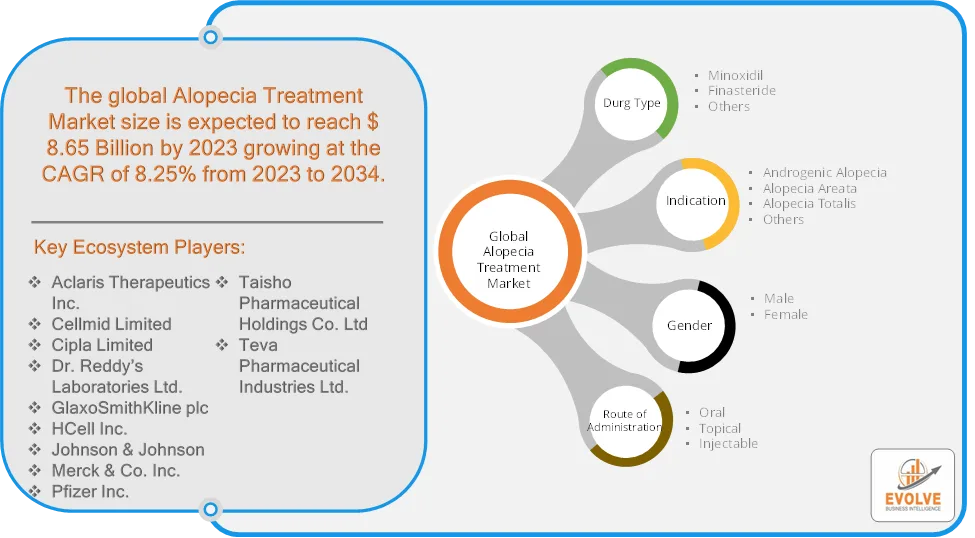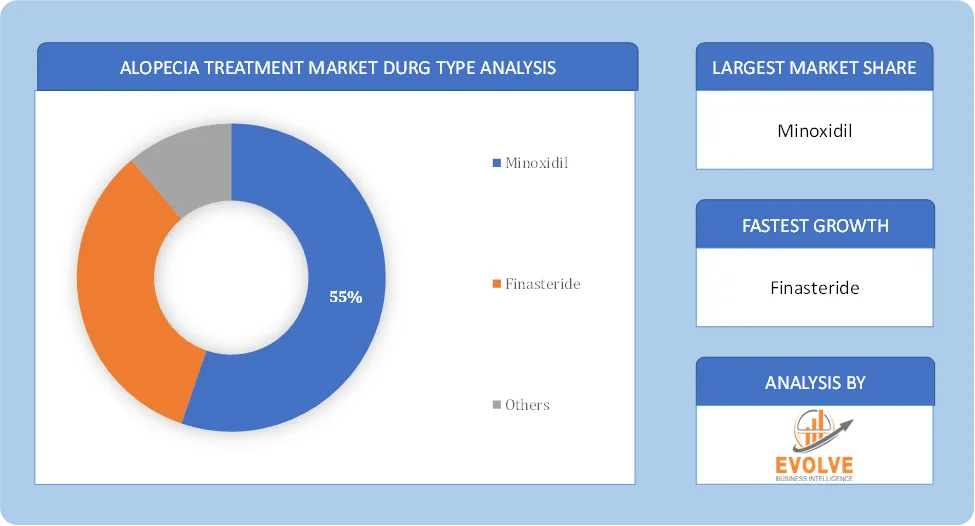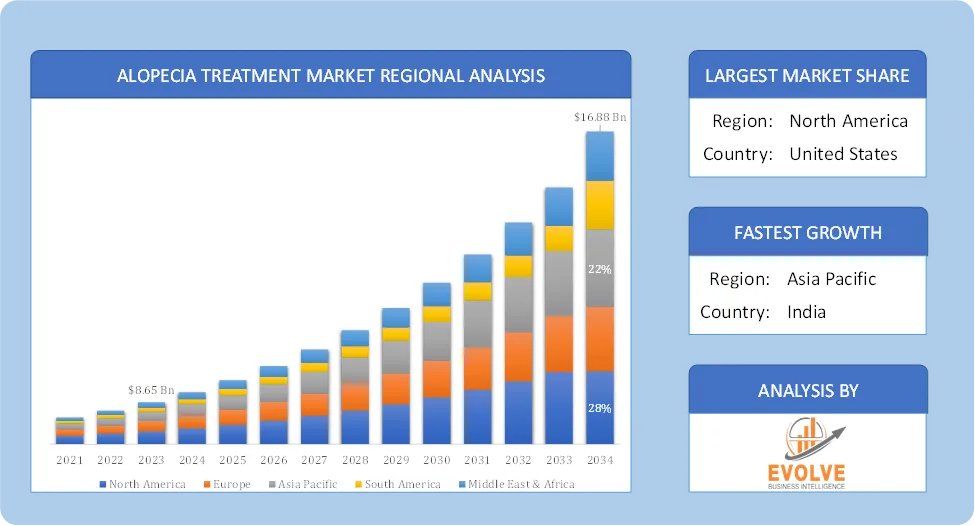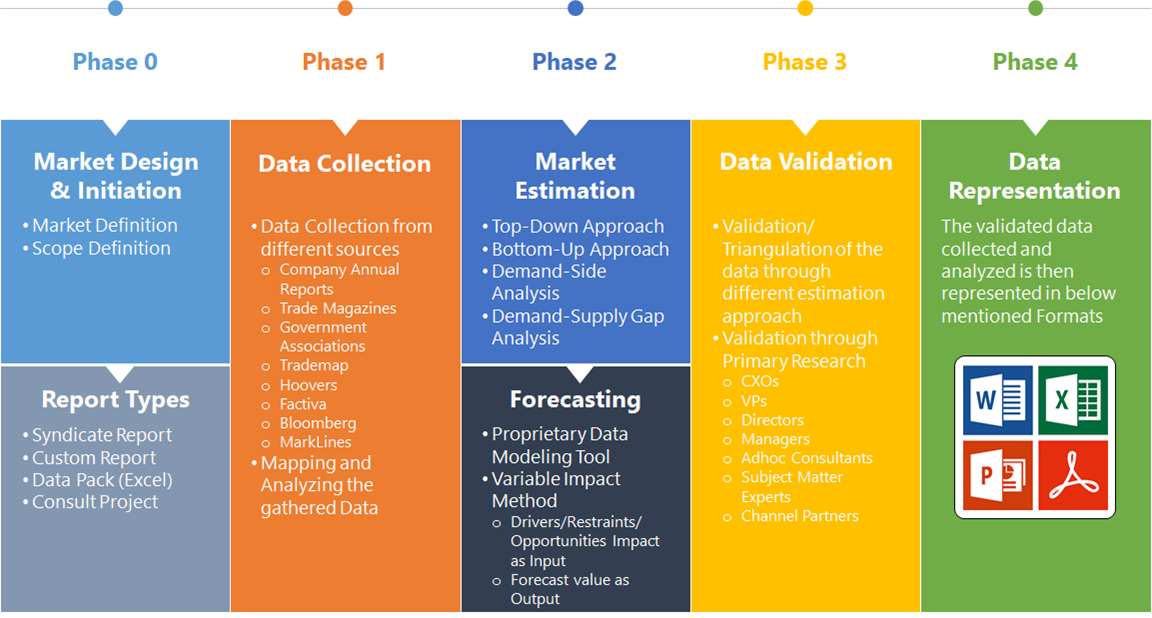Alopecia Treatment Market Overview
The Alopecia Treatment Market size accounted for USD 8.65 Billion in 2023 and is estimated to account for 9.25 Billion in 2024. The Market is expected to reah USD 16.88 Billion by 2034 growing at a compound annual growth rate (CAGR) of 8.25% from 2024 to 2034. The global alopecia treatment market has been experiencing significant growth, driven by increasing awareness of hair loss conditions and advancements in therapeutic solutions. This growth is attributed to several factors, including the rising prevalence of hair loss conditions such as androgenetic alopecia and alopecia areata, technological advancements in treatment options, and a growing emphasis on aesthetic appearance among consumers.
The market comprises various treatment options, including topical agents like minoxidil, oral medications such as finasteride, and advanced therapies like low-level laser therapy and hair transplantation surgeries. the alopecia treatment market is poised for substantial growth, with increasing consumer awareness and technological advancements playing pivotal roles in its expansion.
Global Alopecia Treatment Market Synopsis
 Alopecia Treatment Market Dynamics
Alopecia Treatment Market Dynamics
The major factors that have impacted the growth of Alopecia Treatment Market are as follows:
Drivers:
Ø Advancements in Treatment Options
Development of targeted therapies, including JAK inhibitors for alopecia areata. Innovations in stem cell therapy, platelet-rich plasma (PRP) therapy, and hair transplantation techniques and growing popularity of low-level laser therapy (LLLT) for non-invasive treatment. Rising demand for hair loss treatments due to increased emphasis on personal appearance and self-confidence and social media influence and celebrity endorsements boosting awareness and product adoption. Leading pharmaceutical companies investing in new drug formulations for alopecia treatment and Clinical trials evaluating the effectiveness of novel topical and oral therapies.
Restraint:
- High Cost of Advanced Treatments and Limited Efficacy of Available Treatments
Hair transplantation, stem cell therapy, and PRP therapy are expensive, limiting affordability for many patients. Maintenance treatments for alopecia (e.g., minoxidil and finasteride) require long-term use, adding to the financial burden. Many alopecia treatments, such as minoxidil and finasteride, show limited effectiveness, with varying results among patients and hair regrowth solutions often take months to show visible improvement, discouraging patient adherence.
Opportunity:
⮚ Advancements in Biotechnology & Regenerative Medicine
Stem cell therapy and platelet-rich plasma (PRP) therapy are gaining traction as promising regenerative solutions. Emerging gene therapy and biologics may provide long-term or permanent hair regrowth solutions. Increasing demand for low-level laser therapy (LLLT) devices and dermarollers for at-home hair restoration and expansion of medicated shampoos, serums, and nutraceuticals that support hair regrowth. Social media, celebrity endorsements, and awareness campaigns are reducing the stigma around alopecia and more consumers are actively seeking preventative hair loss treatments at an earlier stage.
Alopecia Treatment Market Segment Overview
Based on Drug Type, the market is segmented based on Minoxidil, Finasteride, Others. The Minoxidil segment dominant the market. Minoxidil is a commonly used medication that effectively treats alopecia in many forms. Minoxidil is a popular and easily accessible therapy option for male and female pattern hair loss. This FDA-approved drug comes in several forms, including foams and topical treatments. It slows down hair loss, stimulates hair growth, and increases blood supply to hair follicles. It is widely adopted due to its relative affordability when compared to prescription drugs and its efficacy in encouraging hair growth.
By Indication
Based on Indication, the market segment has been divided into Androgenic Alopecia, Alopecia Areata, Alopecia Totalis, Others. The Androgenic Alopecia segment dominant the market. Androgenic alopecia, commonly known as male or female pattern baldness, holds the largest segment in the market. It is primarily due to the high prevalence of androgenic alopecia globally, which affects a significant portion of men and women. The rising awareness and acceptance of treatment options, coupled with advances in therapeutic techniques such as topical treatments, oral medications, and hair transplant procedures, have further propelled the market growth.
By Gender
Based on Gender, the market segment has been divided into Male and Female. Female segment dominant the market. The growing prevalence of alopecia in females coupled with a growing awareness and acceptance of medical treatments for hair loss are influencing the market growth. Women are seeking effective solutions for alopecia due to aesthetic concerns and the psychological impact of hair loss, leading to a significant demand for pharmaceutical and cosmetic treatments.
By Route of Administration
Based on Route of Administration, the market segment has been divided into Oral, Topical and Injectable. Topical segment dominant the market. Topical therapies, including minoxidil and corticosteroids, are non-invasive, can be administered directly to the afflicted area, and have fewer systemic adverse effects than oral and injectable options, and are frequently the first line of defense against hair loss. This route of administration is attributed to its popularity among patients who want quick fixes that work well without requiring physician care.
Global Alopecia Treatment Market Regional Analysis
Based on region, the global Alopecia Treatment Market has been divided into North America, Europe, Asia-Pacific, the Middle East & Africa, and Latin America. North America is projected to dominate the use of the Alopecia Treatment Market followed by the Asia-Pacific and Europe regions.
 North America Alopecia Treatment Market
North America Alopecia Treatment Market
North America holds a dominant position in the Alopecia Treatment Market. North America region has largest market share due to the high prevalence of alopecia. It has strong presence of leading pharmaceutical companies and advanced R&D initiatives and High consumer spending on cosmetic treatments and aesthetic procedures. Increasing adoption of FDA-approved medications and rising demand for hair transplant procedures and PRP therapy.
Asia-Pacific Alopecia Treatment Market
The Asia-Pacific region has indeed emerged as the fastest-growing market for the Alopecia Treatment Market industry. Due to the rising population, urbanization, and changing lifestyle habits. High prevalence of alopecia in China, India, Japan, and South Korea due to stress, pollution, and diet changes and strong growth in the hair transplant industry, particularly in India and South Korea. Increasing disposable income leading to higher spending on cosmetic treatments and Rapid expansion of online pharmacies and telemedicine platforms for hair loss treatments.
Competitive Landscape
The global Alopecia Treatment Market is highly competitive, with numerous players offering a wide range of software solutions. The competitive landscape is characterized by the presence of established companies, as well as emerging startups and niche players. To increase their market position and attract a wide consumer base, the businesses are employing various strategies, such as product launches, and strategic alliances.
Prominent Players:
- Aclaris Therapeutics Inc.
- Cellmid Limited
- Cipla Limited
- Reddy’s Laboratories Ltd.
- GlaxoSmithKline plc
- HCell Inc.
- Johnson & Johnson
- Merck & Co. Inc.
- Pfizer Inc.
- Taisho Pharmaceutical Holdings Co. Ltd
- Teva Pharmaceutical Industries Ltd. etc.
Key Development
In December 2023: Aclaris Therapeutics, Inc. entered into an exclusive USD 15 Million patent license agreement with Sun Pharma. Aclaris granted Sun Pharma exclusive rights to specific patents for the use of deuruxolitinib, Sun Pharma’s JAK inhibitor, or other isotopic forms of ruxolitinib, to treat alopecia areata (AA) and androgenetic alopecia (AGA).
Scope of the Report
Global Alopecia Treatment Market, by Durg Type
- Minoxidil
- Finasteride
- Others
Global Alopecia Treatment Market, by Indication
- Androgenic Alopecia
- Alopecia Areata
- Alopecia Totalis
- Others
Global Alopecia Treatment Market, by Gender
- Male
- Female
Global Alopecia Treatment Market, by Route of Administration
- Oral
- Topical
- Injectable
Global Alopecia Treatment Market, by Region
- North America
- US
- Canada
- Mexico
- Europe
- UK
- Germany
- France
- Italy
- Spain
- Benelux
- Nordic
- Rest of Europe
- Asia Pacific
- China
- Japan
- South Korea
- Indonesia
- Austalia
- Malaysia
- India
- Rest of Asia Pacific
- South America
- Brazil
- Argentina
- Rest of South America
- Middle East & Africa
- Saudi Arabia
- UAE
- Egypt
- South Africa
- Rest of Middle East & Africa
| Parameters | Indicators |
|---|---|
| Market Size | 2034: USD 16.88 Billion |
| CAGR (2024-2034) | 8.25% |
| Base year | 2022 |
| Forecast Period | 2024-2034 |
| Historical Data | 2021 (2017 to 2020 On Demand) |
| Report Coverage | Revenue Forecast, Competitive Landscape, Growth Factors, and Trends |
| Key Segmentations | Drug Type, Indication, gender, Route of Administration |
| Geographies Covered | North America, Europe, Asia-Pacific, South America, Middle East, Africa |
| Key Vendors | Aclaris Therapeutics Inc., Cellmid Limited, Cipla Limited, Dr. Reddy’s Laboratories Ltd., GlaxoSmithKline plc, HCell Inc., Johnson & Johnson, Merck & Co. Inc., Pfizer Inc., Taisho Pharmaceutical Holdings Co. Ltd and Teva Pharmaceutical Industries Ltd. etc. |
| Key Market Opportunities | · Advancements in Biotechnology & Regenerative Medicine · Growing Popularity of Non-Invasive & At-Home Treatments |
| Key Market Drivers | · Advancements in Treatment Options · Increasing Consumer Awareness & Aesthetic Concerns |
REPORT CONTENT BRIEF:
- High-level analysis of the current and future Alopecia Treatment Market trends and opportunities
- Detailed analysis of current market drivers, restraining factors, and opportunities in the future
- Alopecia Treatment Market historical market size for the year 2021, and forecast from 2023 to 2033
- Alopecia Treatment Market share analysis at each product level
- Competitor analysis with detailed insight into its product segment, Government & Defense strength, and strategies adopted.
- Identifies key strategies adopted including product launches and developments, mergers and acquisitions, joint ventures, collaborations, and partnerships as well as funding taken and investment done, among others.
- To identify and understand the various factors involved in the global Alopecia Treatment Market affected by the pandemic
- To provide a detailed insight into the major companies operating in the market. The profiling will include the Government & Defense health of the company’s past 2-3 years with segmental and regional revenue breakup, product offering, recent developments, SWOT analysis, and key strategies.








